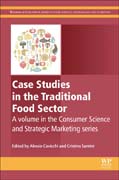
Consumer Science and Strategic Marketing: Case Studies in the Traditional Food Sector
Cavicchi, Alessio
Santini, Cristina
Consumer Science and Strategic Marketing: Case Studies in the Traditional Food Sector aims to close the gap between academic researchers and industry professionals through real world scenarios and field-based research. The book explores how consumer and sensory science has been implemented in the food industry for achieving the following strategic aims: rejuvenating product image, shaping new market places, achieving market differentiation and geographical diffusion, achieving customer loyalty, promoting traditional features of the product and defining product positioning in competitive environment. There is an emerging demand from food industry professionals and undergraduate and postgraduate students who attend business and agricultural studies courses who want to gain practical information through real cases and field-based research. This book aims to answer the following questions, amongst others: How research in the field of consumer science became relevant for marketing strategies?, Which tangible economic and financial outcomes have been obtained by the joint work of sensory scientists, researchers in marketing field and food business professionals?, and which communication methods and practices have been relevant to make the most of R&D in the food industry? Through case studies, successful examples and practices are provided, with newer inputs for further theoretical investigation given. Both current and future professionals in the food industry will gain insights that can be used in their business environment. Bridges the gap between scholars and practitioners in understanding consumers in the traditional food sectorAllows scientists and professionals to make the most of R&D outcomesAdvances consumer science research to address business problems in the food industry INDICE: 1. Introduction Part I: Market outlook, factors and trends 2. Traditional food: definitions and nuances 3. Global trends in traditional food production and retailing 4. Consumer behavior towards traditional products 5. R&D, the myth: where is research going to? What is the role of consumer science as a business tool in traditional food sector? Part II: New and innovative products: the role of consumer science 6. How can Consumer Science help to reduce the risk of market failure? 7. What is the role of CS in helping new products development? 8. What are the benefits for a company that employs consumer science in product/process innovation? Part III: Sustaining the growth: consumer science and market growth 9. How CS can be employed in a market growth strategy? 10. How CS can be used for producing info that can be employed in strategy making? Part IV: Mature products in a mature business: when consumer science helps with repositioning or rejuvenating a mature product 11. How firms can use CS when their products achieve the peak of the product life cycle and they get into the decline phase? 12. How firms can transform their dog (BCG matrix) products into profitable ones by employing CS? Part V: Interpreting market dynamics and demand: consumer science as a mean to achieve strategic information 14. How CS can be used for gaining info about consumers and the market? 15. How do firms process info? 16. How do firms use consumer science to optimize internal information flows and communication 17. Conclusions Appendix: further insights on methodological tools adopted in this book
- ISBN: 978-0-08-101007-5
- Editorial: Woodhead Publishing
- Encuadernacion: Rústica
- Páginas: 352
- Fecha Publicación: 01/09/2017
- Nº Volúmenes: 1
- Idioma: Inglés
